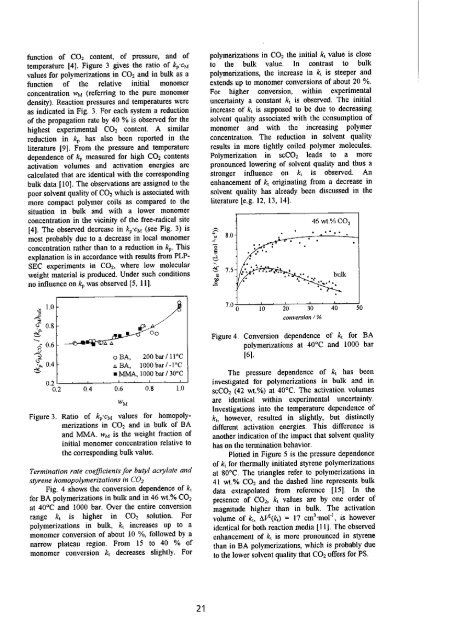March 3 - 5,1999, Karlsruhe, Germany - FZK
March 3 - 5,1999, Karlsruhe, Germany - FZK
March 3 - 5,1999, Karlsruhe, Germany - FZK
Create successful ePaper yourself
Turn your PDF publications into a flip-book with our unique Google optimized e-Paper software.
function of C0 2 content, of pressure, and of<br />
temperature [4]. Figure 3 gives the ratio of kp-c M<br />
values for polymerizations in C0 2 and in bulk as a<br />
function of the relative initial monomer<br />
concentration w M (referring to the pure monomer<br />
density). Reaction pressures and temperatures were<br />
as indicated in Fig. 3. For each system a reduction<br />
of the propagation rate by 40 % is observed for the<br />
highest experimental C0 2 content. A similar<br />
reduction in kp has also been reported in the<br />
literature [9], From the pressure and temperature<br />
dependence of kp measured for high C0 2 contents<br />
activation volumes and activation energies are<br />
calculated that are identical with the corresponding<br />
bulk data [10]. The observations are assigned to the<br />
poor solvent quality of C0 2 which is associated with<br />
more compact polymer coils as compared to the<br />
situation in bulk and with a lower monomer<br />
concentration in the vicinity of the free-radical site<br />
[4]. The observed decrease in kp-c u (see Fig. 3) is<br />
most probably due to a decrease in local monomer<br />
concentration rather than to a reduction in kp. This<br />
explanation is in accordance with results from PLP-<br />
SEC experiments in C0 2, where low molecular<br />
weight material is produced. Under such conditions<br />
no influence on k p was observed [5, 11],<br />
1.0 i<br />
0.8<br />
0.6<br />
o BA, 200bar/ll°C<br />
0.4 A BA, 1000bar/-l°C<br />
• MMA, 1000 bar/30°C<br />
0.2 2 I . i<br />
1 , . i 1<br />
i<br />
• i '<br />
i<br />
• '—<br />
1—<br />
0.2 0.4 0.6 0.8 1.0<br />
Figure 3. Ratio of kp-c M<br />
values for homopoly<br />
merizations in C0 2 and in bulk of BA<br />
and MMA. w M is the weight fraction of<br />
initial monomer concentration relative to<br />
the corresponding bulk value.<br />
Termination rate coefficients for butyl acrylate and<br />
styrene homopolymerizations in C0 2<br />
Fig. 4 shows the conversion dependence of k t<br />
for BA polymerizations in bulk and in 46 wt.% C0 2<br />
at 40°C and 1000 bar. Over the entire conversion<br />
range k t is higher in C0 2 solution. For<br />
polymerizations in bulk, k t increases up to a<br />
monomer conversion of about 10 %, followed by a<br />
narrow plateau region. From 15 to 40 % of<br />
monomer conversion k { decreases slightly. For<br />
21<br />
polymerizations in C0 2 the initial kt value is close<br />
to the bulk value. In contrast to bulk<br />
polymerizations, the increase in k { is steeper and<br />
extends up to monomer conversions of about 20 %.<br />
For higher conversion, within experimental<br />
uncertainty a constant h is observed. The initial<br />
increase of kt is supposed to be due to decreasing<br />
solvent quality associated with the consumption of<br />
monomer and with the increasing polymer<br />
concentration. The reduction in solvent quality<br />
results in more tightly coiled polymer molecules.<br />
Polymerization in scC0 2 leads to a more<br />
pronounced lowering of solvent quality and thus a<br />
stronger influence on k t is observed. An<br />
enhancement of k t originating from a decrease in<br />
solvent quality has already been discussed in the<br />
literature [e.g. 12, 13, 14].<br />
46 wt.% C0 2<br />
7 0-1 , 1 . 1 . 1 . 1 • '<br />
/ , U<br />
0 10 20 30 40 50<br />
conversion / %<br />
Figure 4. Conversion dependence of h for BA<br />
polymerizations at 40°C and 1000 bar<br />
[6].<br />
The pressure dependence of kt has been<br />
investigated for polymerizations in bulk and in<br />
scC02 (42 wt.%) at 40°C. The activation volumes<br />
are identical within experimental uncertainty.<br />
Investigations into the temperature dependence of<br />
kt, however, resulted in slightly, but distinctly<br />
different activation energies. This difference is<br />
another indication of the impact that solvent quality<br />
has on the termination behavior.<br />
Plotted in Figure 5 is the pressure dependence<br />
of fct for thermally initiated styrene polymerizations<br />
at 80°C. The triangles refer to polymerizations in<br />
41 wt.% C0 2 and the dashed line represents bulk<br />
data extrapolated from reference [15]. In the<br />
presence of C02, kt values are by one order of<br />
magnitude higher than in bulk. The activation<br />
volume of kt, AJ% t) = 17 cm 3<br />
-mol"\ is however<br />
identical for both reaction media [11]. The observed<br />
enhancement of k t is more pronounced in styrene<br />
than in BA polymerizations, which is probably due<br />
to the lower solvent quality that C0 2 offers for PS.












![{A1[]Sp - Bibliothek](https://img.yumpu.com/21908054/1/184x260/a1sp-bibliothek.jpg?quality=85)




